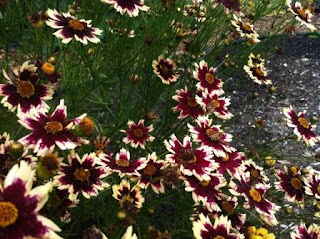At the Seattle Community Farm, we've been making some exciting improvements to the Children’s Garden!
With the help of our learners from the Rainier Vista Boys and Girls Club this summer, we rehabilitated the worm bins, and learned all about worms, composting, and the nutrients the soil needs to grow healthy vegetables.
Amelia painted a big sign welcoming visitors to the Children’s Garden, and we made signs identifying all the new and interesting plants growing in the garden. We planted cilantro, radishes, spinach, and beets with our students this summer, and now visitors to the garden will know exactly what’s growing where.
We've also planted marigolds and other cheerful flowers at the end of each bed to add beauty and invite our favorite helpers, the bees, to visit our garden.
 |
| Laminated signs decorated by the children let visitors know what’s growing where. |
Sensory Garden
This year we've established a Sensory Exploration Garden filled with plants that invite you to look, smell, touch, and taste. (We haven’t yet found a plant that specifically invites listening, but then, plants are generally pretty silent!)Look
In the bed with a large ‘eye’ sign, we have planted beautiful and colorful flowers to admire. We use this bed to learn about pollination and the ways plants have evolved to attract a flower’s best friend: the bee! |
| The flowers growing in our “see” bed are popular among bees and human visitors alike. |
Smell
In the bed marked with a big ‘nose’, we invite our learners to sniff deeply and smell the aromatic herbs, sweet-smelling flowers…and one plant that’s a little more unusual.The so-called “curry plant”, Helichrysam italicum, may smell exactly like curry powder, but it has nothing to do with the mixture of spices used to flavor curries. It’s actually a member of the daisy family! While it’s not used as a masala spice, the oil from its small yellow blossoms does have some interesting medicinal properties. It’s anti-inflammatory, fungicidal, and astringent and can be used to soothe chapped skin and burns. Kids love the surprising smell of the curry plant, and based on its popularity we also added one to the Children’s Garden at Marra Farm.
 |
| One of our baby curry plants. Scrubby and small, it doesn't look like much, but the aroma is sure to impress. |
We also have another unusual plant: the South African Glumicalyx goseloides. At first it impresses us with its pretty little orange flowers, but a closer sniff reveals why it’s more commonly known as “Nodding Chocolate Flower.”
 |
| The Nodding Chocolate Flower takes its name seriously, obediently nodding and smelling like chocolate. |
Taste
Behind, in the bed marked with a big ‘mouth’, we have two large specimens of that all-time kid favorite: common or garden sorrel.Known as the “sour plant” among the kids, who love to munch on it as we explore the garden, sorrel is a perennial herb with a sharp, sour, taste. This taste comes from oxalic acid, which is actually a poison! It’s harmless in small quantities, however, and the plant has been cultivated all over the world for centuries. From Belgium to Nigeria to India to Romania to Vietnam, different food cultures prize the refreshing flavor of sorrel and include it in dishes ranging from mashed potatoes to cooked eel to sour soup.
While their garden teachers agree that the taste is somewhat overwhelming, the kids just can’t get enough of it!
 |
Sorrel grows vigorously. Perhaps it realizes that because of
its popularity,
half of its leaves will be eaten by students during the next
class!
|
Mint Bed
Finally, we have an entire bed dedicated wholly to mint. But not just any old mint…we have half a dozen varieties!From pineapple mint to ginger mint to “chewing gum mint” and even a very convincingly smelling chocolate mint, kids love to touch, smell, and taste the different varieties.
 |
| Chewing Gum Mint, one of the many varieties growing in the mint bed. |
Plants with unusual appearances, aromas, and flavors appeal to the kids’ sense of wonder, encourage us to marvel at the sheer diversity of the natural world and engage us with (almost) all our senses.
The Sensory Exploration Garden is a popular addition to the Children’s Garden at the Seattle Community Farm, and will serve as a valuable hands-on teaching aid as it grows in the years to come.
-Cordelia, summer Children's Garden and Nutrition Education intern
Thank you so much, Cordelia, for all your work with Lettuce Link this summer on the sensory beds and signs, teaching children, taking photos, writing blog posts, and much more. We miss you already!


No comments:
Post a Comment